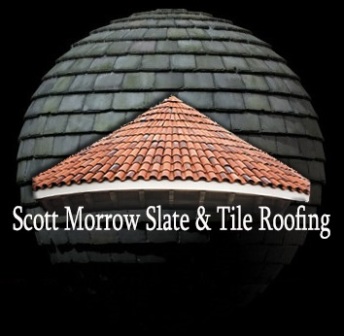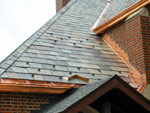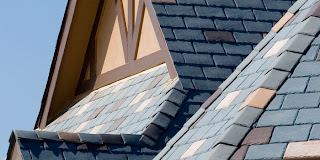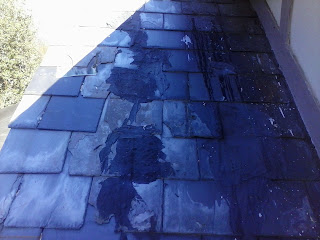Slate is one of the most durable roof
options available today. There are some slate roofs that have been around for
centuries. While asphalt shingles may be popular because of their
low cost,
Slate is still a better choice for many reasons. Here's are a few reasons why it makes
a better roofing choice.
Classic Beauty
Slate has been used in Europe for hundreds of
years. They provide a classic look that modern imitations can't
match. Roofing slates come in many colors, from
classic black, grey and brown to greenish and even shades of purple. The slate will weather, developing its own unique characteristics.
Man made roof coverings tend to look the same until they wear out
and must be thrown away.
Longevity
Even if a slate roof is made using traditional hook or fixed by
nail, it will last much longer than almost any other type of roof.
Slate roofs can stay water tight for 80 to 100+ years with only very little maintenance. Even when a roof approaches this age, it rarely needs
to be totally replaced.
Most slate roofs need some work as
they get older, but many
slate-roofed cathedrals and buildings have lived to
be hundreds of years old. Compared to a asphalt shingle
roofing system, which lasts only for about 15 to 20 years, or a metal roof, which
lasts up to 40 years, slate is the longest option there is.
Durability
As well as lasting a long time,
slate roofs will survive harsh
weather and other rough conditions without too many issues.
Slate is water-resistant, while only absorbing to only about 0.4
percent. which means that it don't crack or fracture in freezing weather
the way that clay tile sometimes does.
Slate roofs also do very well in
high winds, such as hurricanes.
Slate roofs have managed to
survive intact through storms that knocked down multiple trees and tare other roofing systems off. The weight and sturdiness of the slate keeps them intact even in hard weather. If a few slates do get damaged, replacing
them is a relatively easy proses.
Hail storms do occasionally
cause damage to a
slate roof. In some cases, the hail can even go right
through the slate. The up side is, the damage occurs only on individual
slates. That makes it easy to repair a hail damaged slate roof without a whole lot of expense or time. There are thinner styles of slate that will incur more damage. But Most of your heavier slate roofs
can often shrug off even large hailstones.
Safety
While
slate is made from stone, it's
fire-resistant, unlike asphalt shingled roofs and plastic-based roofing systems.
Slate is also a good electrical insulator, which was why it
was originally used in early electric motors.
Slate is very
stable and strong, reducing damage from hail or fallen
electrical wires, hard rain, snow and other damaging
factors.
Environmental Impact
Slate has a natural origin and last almost forever,
slate roofs have some
of the lowest environmental effects of any roof system. In most
cases, slate is quarried from quarries close by. For instance, many of
the
slate roofs in Europe use Spanish stone for their shingles. In the
UK, Welsh slate is considered some of the most beautiful. US
homes often use Pennsylvanian, Vermont, or Virginia slate.
Scott Morrow has 20 years experience in the slate and tile roofing industry and has an extensive background and knowledge of modified rubber applications as well as custom copper fabrication applications.




.jpg)
.jpg)
.jpg)




